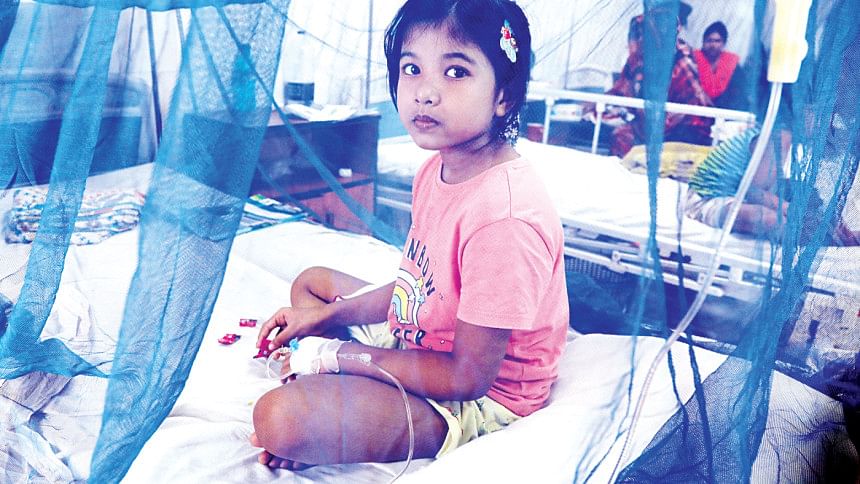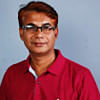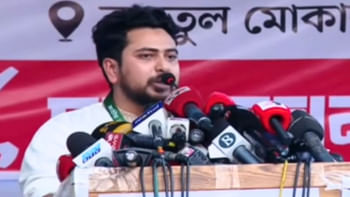900 dengue cases logged in a day

At least 10,846 dengue patients were admitted to hospitals across the country in only 17 days this month, up from 9,911 in the entire month of September.
Also, the number of deaths this month has gone up to 44 until yesterday morning against the previous month's figure of 34.
According to the Directorate General of Health Services, three dengue patients died and 900 others were admitted to hospitals across the country in 24 hours preceding yesterday morning. This is highest figure of dengue cases recorded in a single day this year.
With the latest cases, this year's total number of dengue patients rose to 26,938. Of them, 7,440 are from outside Dhaka, shows DGHS data.
The 99 deaths recorded so far this year is the third highest in a single year.
Fifty-five of the deaths were recorded in Dhaka, 22 in Cox's Bazar, 12 in Chattogram, five in Barishal, two in Khulna, and one each in Narsingdi, Mymensingh and Feni.
Experts have called upon the city corporations to take immediate measures to kill Aedes mosquitoes, the carrier of dengue.
A recent analysis of the patient data by the DGHS has revealed that the dengue infection rate is highest among people aged over 20 while the death rate is high among patients aged between 40-80 years.
It also showed that most of dengue patients who died at hospitals breathed their last within three days of being admitted to hospitals.
Tahmina Shirin, director of the Institute of Epidemiology, Disease Control and Research (IEDCR), suggested taking sufficient fluids like oral saline, fruit juice, sorbet and coconut water if anyone gets fever, a major symptom of dengue.
"A fever patient will continue taking fluids even after recovery as there is still a chance that theirhealth would deteriorate."
Patients need to be hospitalised when they feel nauseous, suffer from abdominal pain, breathing problems or bleeding from any parts of their body, Tahmina said.
HM Nazmul Ahsan, associate professor at Shaheed Suhrawardy Medical College and Hospital, said severity of dengue infections can be avoided if the cases are diagnosed at an early stage.
For diagnosing dengue, a person has to undergo an NS1 test on the first day of getting fever. High fever, body pain and headache are some common symptoms of dengue, he said.
A monsoon survey by the DGHS, conducted between August 11 and 23, found the presence of Aedes mosquitoes in 13.4 percent houses in Dhaka North City Corporation (DNCC) area and 11.75 percent homes in Dhaka South City Corporation (DSCC) area.
A total of 1,319 households under 40 DNCC wards and 1,830 households under 58 DSCC wards were surveyed. The study also identified 13 DNCC wards and 14 DSCC wards as high-risk areas for dengue infection as the density of Aedes mosquitoes was higher in those wards.
Dr Md Ekramul Haque, deputy programme manager of malaria and ATD control programme at the DGHS, said they have already sent dengue diagnostic kits to every upazila and asked all hospital authorities to arrange separate wards for patients, if necessary.
Entomologist GM Saifur Rahman of National University said as short-term measures, the authorities concerned will have to conduct surveys in risky areas to find out symptomatic or mild dengue patients.
They will also have to carry out intensive mosquito control operations in those areas to kill mosquitoes and build public awareness, he added.
The government, as long-term initiatives, should guide the municipalities and district authorities properly, said Saifur.
Prof Kabirul Bashar, an entomologist of Jahangirnagar University, said a national vector control guideline and its proper implementation is necessary to control Aedes mosquito population.
A separate institute should be set up to conduct research and regularly share updates with the agencies involved in eradicating Aedes, he told The Daily Star.
"The institute will carry out research on all kinds of vectors like sun fly [which spreads kala azar], bed bugs and mosquitoes."
Entomologist Manzur A Chowdhury said dengue has already become an epidemic in the country.
Stressing the need for identifying the clusters of Aedes mosquitos, he said the authorities will have to collect the addresses of dengue patients for identification purposes.
"They will also have to take effective measures within a 500-yard radius of the homes of dengue patients. This measure is called hotspot management," added Manzur.

 For all latest news, follow The Daily Star's Google News channel.
For all latest news, follow The Daily Star's Google News channel. 



Comments